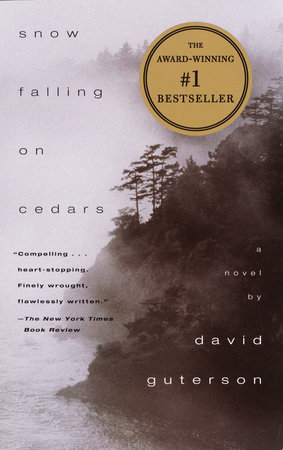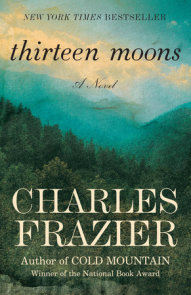READERS GUIDE
The discussion topics, author biography, historical material, and bibliography that follow are meant to enhance your group’s reading of David Guterson’s Snow Falling on Cedars. We hope that they will provide you with new ways of looking at–and talking about–a novel that has been widely praised for its eloquent dramatization of themes of love, justice, racism, community, and conscience. These ideas arise organically from the book’s suspenseful story of a murder trial, its evocation of a lost love, and its brooding, poetically nuanced portraits of character and place.Introduction
The place is the fictional island of San Piedro off the coast of Washington, a community of "five thousand damp souls" [p. 5] who support themselves through salmon fishing and berry farming. The time is 1954, eight years after the end of World War II, in which some of San Piedro’s young men lost their lives and many others were irreparably injured, physically as well as emotionally.Now one of those survivors–a gill-netter named Carl Heine–has drowned under mysterious circumstances and another fisherman is on trial for his murder. The fact that the accused, Kabuo Miyamoto, is a first-generation Japanese American is not mere coincidence. To the local coroner, Heine’s injuries suggested that the sheriff look for "a Jap with a bloody gun butt" [p. 59]. And among San Piedro’s Anglos, hostility against Japanese still runs high, even if, like Kabuo, those Japanese were born and raised on the island and fought for the United States during the war. Kabuo’s trial, in a sense, is a continuation of the white community’s quarrel with its Asian neighbors.
But the Japanese–and particularly Kabuo and his wife, Hatsue–have their own grounds for resentment, stemming from years of bigotry that culminated during World War II, when thousands of Japanese Americans were interned in government relocation camps and Kabuo was effectively robbed of land that his father had worked and paid for. Even as the state presents its case against Kabuo Miyamoto, the reader is compelled to recognize the Miyamotos’ case against their white neighbors, the best of whom stood by as an entire community was driven into exile. Their case never receives a public hearing: it can only be prosecuted in the courtrooms of memory and conscience.
It is not only the Japanese who remember. Among the trial’s observers is Ishmael Chambers, the embittered war veteran who runs the San Piedro Review. Ishmael is not an objective witness. He grew up with Carl and Kabuo. He lost an arm on Tarawa to Japanese machinegun fire. Most important, Hatsue was Ishmael’s boyhood love and he has never come to terms with losing her. In the course of the trial he will find himself torn between rancor and conscience, loath to forgive Hatsue yet unable to condemn her husband. To a large extent, Snow Falling on Cedars is about the ways in which Ishmael, Kabuo, and Hatsue at last acknowledge their respective losses and recognize the sense of mutual indebtedness and need that may survive even the gravest injuries and betrayals–the way in which loss itself may become a kind of kinship. In a place as isolated as San Piedro, "identity was geography instead of blood" [p. 206] and people make enemies reluctantly, knowing that "an enemy on an island is an enemy forever" [p. 439]. The snow that falls on David Guterson’s hauntingly imagined world falls on everyone who lives in it.
Historical Background
Between 1901 and 1907, almost 110,000 Japanese immigrated to the United States. They were drawn by promises of ready work–American railroads actually sent recruiters to Japanese port cities, offering laborers three to five times their customary wages–and by worsening economic conditions in their homeland, which was undergoing social upheaval in the aftermath of the Meiji Restoration. Although many originally came as dekaseginin–temporary sojourners–work was plentiful, not only on the railroads, but in the lumber camps, salmon fisheries, and fruit orchards of Oregon and Washington. Increasingly, the newcomers stayed on. Many purchased their own farms. In time, these issei–first-generation Japanese–started families.
The Japanese government actively encouraged emigration, and although the Gentleman’s Agreement of 1908 curbed the flow of Japanese men, it allowed unrestricted entry to their wives and children. Many women were "picture brides," who came to join husbands they knew only through photographs and letters and whom they had "married" by proxy in ceremonies in their native villages.
Very quickly the newcomers encountered antagonism. Although Japanese constituted less than two percent of all immigrants to the U.S., newspapers trumpeted an "invasion." The mayor of San Francisco proclaimed that "the Japanese are not the stuff of which American citizens can be made." The Sacramento Bee warned that "the Japs…will increase like rats" if allowed to settle down. The Asiatic Exclusion League agitated for legislation to halt all Japanese immigration. Politicians ran for office on anti-Japanese platforms. In 1923, the state of Oregon prohibited issei from legally buying land. A year later, Congress passed the National Origins Act, which banned all immigration from Japan.
In spite of this, the newcomers thrived. They found ways of getting around some laws (under Oregon’s Alien Land Law, first-generation Japanese could legalize their land purchases by registering them in the names of their American-born-or nisei-children). They tolerated other laws. Meanwhile, the immigrants preserved the ceremonies and values of Japan even as they encouraged their children to acculturate and, particularly, to educate themselves. "You must outperform your detractors," one issei counseled his children. Typically, the nisei grew up thinking of themselves as Americans, yet were reminded of their difference every time they encountered the taunts and ostracism of their white neighbors.
Following the Japanese surprise attack on Pearl Harbor on December 7, 1941, hostility turned into paranoia–and paranoia became law. Japanese who had lived in America for thirty years were accused of spying for their native land. The day after Pearl Harbor, the U.S. Treasury Department ordered all Japanese-owned businesses closed and all issei bank accounts frozen. The U.S. government had already compiled lists of Japanese whose loyalties might be suspect, and more than 1,000 businessmen, community leaders, priests, and educators were arrested up and down the West Coast.
The restrictions escalated. Japanese homes were searched for contraband. Telephone service was cut off. One newspaper columnist wrote: "I am for the immediate removal of every Japanese on the West Coast to a point deep in the interior….Herd ’em up, pack ’em off and give ’em the inside room in the badlands…let ’em be pinched, hurt, and hungry." In February 1942, President Franklin Roosevelt signed Executive Order 9066, which empowered the government to remove "any and all" persons of Japanese ancestry from sensitive military areas in four western states. Japanese residents had only days in which to evacuate. They were compelled to sell their land and businesses for a fraction of their value, or to lease them to neighbors who would later refuse to pay their rent. All told, some 110,000 Japanese Americans were deported from their homes to hastily built camps such as Tule Lake and Manzanar, where they lived behind barbed wire for the duration of the war.
Neither Germans nor Italians living in this country were subject to similar restrictions, and recently declassified documents reveal that the Japanese population was never considered a serious threat to American security. In all of World War II, no person of Japanese ancestry living in the United States, Alaska, or Hawaii was ever charged with any act of espionage or sabotage. As one nisei later wrote, the victims of Executive Order 9066 were people whose "only crime was their face."
In 1988, the U.S. government formally apologized to Japanese citizens who had been deprived of their civil liberties during World War II.
This information was gathered from Lauren Kessler, Stubborn Twig: Three Generations in the Life of a Japanese-American Family. New York, Random House, 1993.
Questions and Topics for Discussion
1. Snow Falling on Cedars opens in the middle of Kabuo Miyamoto’s trial. It will be pages before we learn the crime of which he has been accused or the nature of the evidence against him. What effect does the author create by withholding this information and introducing it in the form of flashbacks? Where else in the narrative are critical revelations postponed? How is this novel’s past related to its fictional present?
2. The trial functions both as this novel’s narrative frame and as its governing metaphor. As we follow it, we are compelled to ask larger questions about the nature of truth, guilt, and responsibility. How does the author interweave these two functions? Which characters are aware that what is at stake is more than one man’s guilt?
3. When the trial begins, San Piedro is in the midst of a snowstorm, which continues throughout its course. What role does snow play–both literally and metaphorically–in the book? Pay particular attention to the way in which snow blurs, freezes, isolates, and immobilizes, even as it holds out the promise of an "impossible winter purity" [p. 8]. How does nature shape this novel?
4. Guterson divides his island setting into four zones: the town of Amity Harbor; the sea; the strawberry fields; and the cedar forest. What actions take place in these different zones? Which characters are associated with them? How does the author establish a different mood for each setting?
5. In his first description of Carl Heine [pp. 14-16], Guterson imparts a fair amount of what is seemingly background information: We learn about his mother’s sale of the family strawberry farm; about Carl’s naval service in World War II; and about his reticence. We learn that Carl is considered "a good man." How do these facts become crucial later on, as mechanisms of plot, as revelations of the dead man’s character, and as clues to San Piedro’s collective mores? Where else does the author impart critical information in a casual manner, often "camouflaging" it amid material that will turn out to have no further significance? What does this method suggest about the novel’s sense of the meaningful–about the value it assigns to things that might be considered random or irrelevant?
6. When Carl’s body is dredged from the water, the sheriff has to remind himself that what he is seeing is a human being. While performing the autopsy, however, Horace Whaley forces himself to think of Carl as "the deceased…a bag of guts, a sack of parts" [p. 54]. Where else in Snow Falling on Cedars are people depersonalized–detached from their identities–either deliberately or inadvertently? What role does depersonalization play within the novel’s larger scheme?
7. What material evidence does the prosecution produce in arguing Kabuo’s guilt? Did these bits of information immediately provoke the investigators’ suspicions, or only reinforce their preexisting misgivings about Carl’s death? Why might they have been so quick to attribute Carl’s death to foul play? How does the entire notion of a murder trial–in which facts are interpreted differently by opposing attorneys–fit into this book’s thematic structure?
8. Ishmael suffers from feelings of ambivalence about his home and a cold-blooded detachment from his neighbors. Are we meant to attribute these to the loss of his arm or to other events in his past? How is Ishmael’s sense of estrangement mirrored in Hatsue, who as a teenager rebels against her mother’s values and at one point declares, "I don’t want to be Japanese" [p. 201]? To what extent do Kabuo and Carl suffer from similar feelings? How does this condition of transcendental homelessness serve both to unite and to isolate the novel’s characters?
9. What significance do you ascribe to Ishmael’s name? What does Guterson’s protagonist have in common with the narrator of Moby-Dick, another story of the sea?
10. What role has the San Piedro Review played in the life and times of its community? How has Ishmael’s stewardship of the paper differed from his father’s? In what ways does he resemble his father–of whom his widow says, "He loved humankind dearly and with all his heart, but he disliked most human beings" [p. 36]? What actions of Ishmael’s may be said to parallel the older man’s?
11. Ishmael’s experience in World War II has cost him an arm. In that same war Horace Whaley, the county coroner, lost his sense of effectiveness, when so many of the men he was supposed to care for died. How has the war affected other characters in this book, both those who served and those who stayed home?
12. Guterson tells us that "on San Piedro the silent-toiling, autonomous gill-netter became the collective image of the good man" [p. 38]. Thus, Carl’s death comes to signify the death of the island’s ideal citizen: he represents a delayed casualty of the war in which so many other fine young men were killed. Yet how productive does the ideal of silent individualism turn out to be? To what extent is Carl a casualty of his self-sufficiency? What other characters in this novel adhere to a code of solitude?
13. Kabuo and Hatsue also possess–and are at times driven by–certain values. As a young girl, Hatsue is taught the importance of cultivating stillness and composure in order "to seek union with the Greater Life" [p. 83]. Kabuo’s father imparts to him the martial codes of his ancestors. How do these values determine their behavior, and particularly their responses to internment, war, and imprisonment? How do they clash with the values of the Anglo community, even as they sometimes resemble them?
14. Racism is a persistent theme in this novel. It is responsible for the internment of Kabuo, Hatsue, and their families, for Kabuo’s loss of his land, and perhaps for his indictment for murder. In what ways do the book’s Japanese characters respond to the hostility of their white neighbors? How does bigotry manifest itself in the thoughts and behavior of characters like Etta Heine–whose racism is keenly ironic in view of her German origins–Art Moran, and Ishmael himself? Are we meant to see these characters as typical of their place and time?
15. Although almost all the novel’s white characters are guilty of racism, only one of them–Etta Heine–emerges unsympathetically. How do her values and motives differ from those of other San Piedrans? How is her hostility to the Japanese related to her distaste for farming? To what extent are Guterson’s characters defined by their feelings for their natural environment?
16. Ishmael’s adolescent romance with Hatsue has been the defining fact of his life, its loss even more wounding than the loss of his arm. Yet when Hatsue first remembers Ishmael, it is only as a "boy" [p. 86] and her recollection of their first kiss is immediately supplanted by the memory of her wedding night with Kabuo. How else does Guterson contrast Hatsue’s feelings for these two men? (Note that Hatsue’s feelings for both Ishmael and her husband become clear in the course of making love.) What does the disparity between Hatsue’s memories and Ishmael’s suggest about the nature of love? Where else in this novel do different characters perceive the same events in radically different ways–and with what consequences?
17. In choosing Kabuo, Hatsue acknowledges "the truth of her private nature" [p. 89]. That choice implies a paradox. For, if Kabuo is a fellow nisei, he is also rooted in the American earth of San Piedro’s strawberry fields. How is this doubleness–between Japanese and American–expressed elsewhere in Snow Falling on Cedars?
18. Ishmael’s attraction to Hatsue is closely connected to a yearning for transcendence, as indicated by their early conversation about the ocean. Ishmael says, "It goes forever," while Hatsue insists, "It ends somewhere" [p. 97]. Typically, it is Ishmael who wishes to dissolve boundaries, Hatsue who keeps reasserting them, as when she gently withholds the embrace that Ishmael so desperately wants. What limits might Ishmael wish to transcend, even as a boy? Does he ever manage to do so? Does Snow Falling on Cedars hold the promise of transcendence for its characters or at best offer them a reconciliation with their limits?
19. One way that Guterson interweaves his novel’s multiple narrative strands is through the use of parallelism: Ishmael spies on Hatsue; so does Kabuo. The two men are similarly haunted by memories of the war. Both Kabuo and Carl Heine turn out to be dissatisfied fishermen who yearn to return to farming. Where else in this novel does the author employ this method, and to what effect?
20. What is the significance of the novel’s last sentence: "Accident ruled every corner of the universe except the chambers of the human heart"?
About this Author
David Guterson was born in Seattle in 1956. His father, Murray Guterson, is a distinguished criminal defense lawyer: “One of the things I heard [from him] early on was to find something you love to do–before you think about money or anything else. The other thing was to do something that you feel has a positive impact on the world.”Guterson received his M.A. from the University of Washington, where he studied under the writer Charles Johnson. It was there that he developed his ideas about the moral function of literature: “Fiction writers shouldn’t dictate to people what their morality should be,” he said in a recent interview. “Yet not enough writers are presenting moral questions for reflection, which I think is a very important obligation.”
After moving to Bainbridge Island in Puget Sound, Guterson taught English at the local high school and began writing journalism for Sports Illustrated and Harper’s magazine, where he is now a contributing editor. He is the author of the novels East of the Mountains, Our Lady of the Forest, The Other, Ed King, and Snow Falling on Cedars, which won the PEN/Faulkner Award; a story collection, The Country Ahead of Us, The Country Behind; and Family Matters: Why Homeschooling Makes Sense. He has three forthcoming books: a memoir, Descent, from Vintage in 2013; a new story collection, Problems with People, from Knopf in 2014; and a book of poems, Songs for a Summons, from Lost Horse Press in 2014. He lives in Washington State.




















